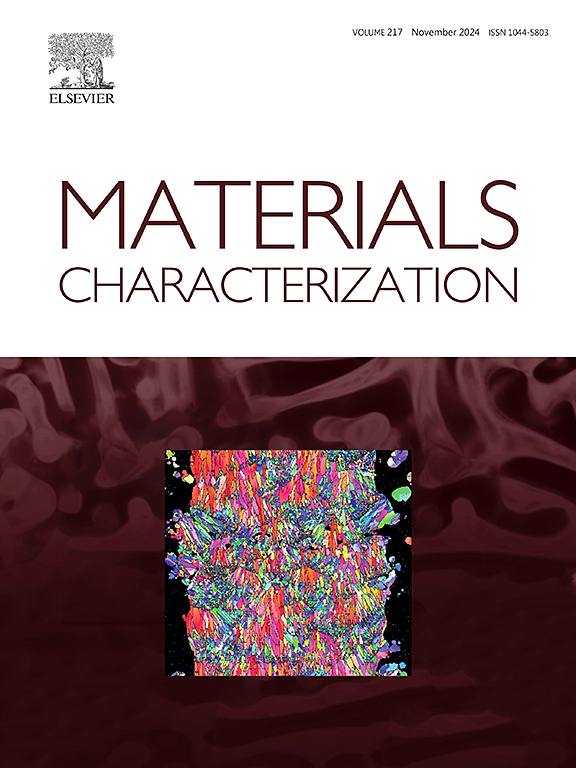Microstructure, mechanical properties and thermal conductivity of Al-1.2Fe alloy fabricated by laser-directed energy deposition
IF 4.8
2区 材料科学
Q1 MATERIALS SCIENCE, CHARACTERIZATION & TESTING
引用次数: 0
Abstract
The Al-1.2Fe (wt%) alloy was fabricated using the laser-directed energy deposition (L-DED) process at various combinations of laser power and scanning speed, followed by laser rescanning (LR) and heat treatment at 873 K for 24 h. The microstructure, mechanical properties, and thermal conductivity were investigated to evaluate the suitability of Al-1.2Fe alloy fabricated by L-DED as heat dissipation material. The results show that the L-DED samples exhibited a multilayered microstructure with coarse columnar structures. The bead thickness was reduced in the LR samples compared to the L-DED samples, but the microstructure remained similar. Heat treatment altered the microstructure, forming spherical and plate-like precipitates of Al6Fe and Al13Fe4. A great number of nano-scale Al6Fe particles predominated in the L-DED sample, while a small number of micro-scale Al13Fe4 particles were found in the heat-treated sample. All samples exhibited elongated α-Al grains along the build direction (BD). The grain size decreased in the order of the L-DED, LR and heat-treated samples. The LR process had negligible effects on hardness and tensile properties. On the other hand, the heat treatment reduced both hardness and tensile properties. The thermal conductivity was slightly improved by the LR process and significantly increased to approximately 30 W/m∙K after the heat treatment. Across all fabrication types (N, R, and H), increases in laser power and scanning speed led to improvements in the tensile properties and thermal conductivity. Additionally, there was clear anisotropy in tensile properties and thermal conductivity. The tensile properties were superior in the horizontal direction along the BD compared to the vertical direction, while the thermal conductivity was higher in vertical direction than in the horizontal direction. The anisotropy in these properties is believed to be primarily caused by the elongated grains along the BD.
激光定向能沉积Al-1.2Fe合金的显微组织、力学性能和导热性能
采用激光定向能沉积(L-DED)工艺,在不同的激光功率和扫描速度组合下制备了Al-1.2Fe (wt%)合金,然后进行激光重扫描(LR)和在873 K下热处理24 h。研究了激光定向能沉积(L-DED)制备的Al-1.2Fe合金的显微组织、力学性能和导热性能,以评价其作为散热材料的适用性。结果表明:L-DED样品呈现出以粗柱状结构为主的多层微观结构;与L-DED样品相比,LR样品的珠层厚度减小,但微观结构保持相似。热处理改变了组织,形成了Al6Fe和Al13Fe4的球状和片状析出相。L-DED样品中存在大量的纳米级Al6Fe颗粒,而热处理样品中存在少量的微尺度Al13Fe4颗粒。所有样品均表现出沿构建方向(BD)拉长的α-Al晶粒。晶粒尺寸依次为L-DED、LR和热处理后的减小。LR工艺对硬度和拉伸性能的影响可以忽略不计。另一方面,热处理降低了硬度和拉伸性能。经LR处理后的导热系数略有提高,热处理后的导热系数显著提高至约30 W/m∙K。在所有制造类型(N, R和H)中,激光功率和扫描速度的增加导致拉伸性能和导热性的改善。此外,在拉伸性能和导热系数方面存在明显的各向异性。沿BD方向的拉伸性能在水平方向优于垂直方向,而导热系数在垂直方向高于水平方向。这些性质的各向异性被认为主要是由沿BD的拉长晶粒引起的。
本文章由计算机程序翻译,如有差异,请以英文原文为准。
求助全文
约1分钟内获得全文
求助全文
来源期刊

Materials Characterization
工程技术-材料科学:表征与测试
CiteScore
7.60
自引率
8.50%
发文量
746
审稿时长
36 days
期刊介绍:
Materials Characterization features original articles and state-of-the-art reviews on theoretical and practical aspects of the structure and behaviour of materials.
The Journal focuses on all characterization techniques, including all forms of microscopy (light, electron, acoustic, etc.,) and analysis (especially microanalysis and surface analytical techniques). Developments in both this wide range of techniques and their application to the quantification of the microstructure of materials are essential facets of the Journal.
The Journal provides the Materials Scientist/Engineer with up-to-date information on many types of materials with an underlying theme of explaining the behavior of materials using novel approaches. Materials covered by the journal include:
Metals & Alloys
Ceramics
Nanomaterials
Biomedical materials
Optical materials
Composites
Natural Materials.
 求助内容:
求助内容: 应助结果提醒方式:
应助结果提醒方式:


